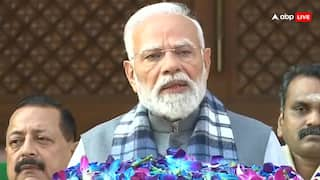Agni-5 To BrahMos: How India's Missiles Are Adding Muscle To Diplomacy
From land to air to sea, India’s missile development programme, started in the early eighties, has given strength and confidence to our strategic planners to deal with rival powers with a firm hand.

The user trial of Agni-5 Intercontinental ballistic Missile on December 15, followed by the December 28 test of the extended range version of BrahMos supersonic cruise missile from a Sukhoi-30 MKI aircraft, was not simply a case of testing a weapon system or adding an additional arrow in the quiver. It was a test of India’s resolve to stand up to the big powers, who had in the past made evry effort to prevent countries like India from acquiring such combat capabilities and becoming a threat militarily, by bringing in several sanctions regimes. The test of the Agni-5 missile, which can travel more than 5,000 km, can bring cities like Beijing and Shanghai etc under its strike range, was a message to China not to play with fire.
The extended range BrahMos supersonic cruise missile, meanwhile, has the capability to destroy any maritime or land-based target from a stand-off distance of over 450 km. It can dominate a huge battle field, either over sea or land, and can enable its own forces to establish total control or dominance over the entire Indian Ocean. A Sukhoi-30 MKI fighter loaded with extended range BrahMos air-to-ground missile can virtually deny any enemy warship a safe passage to the Indian Ocean. The designers of BrahMos supersonic cruise missile, a joint venture by Indian and Russian missile scientists, are now aiming to develop an 800-1,200 km range hypersonic missile, which can escape any counter missile and accurately hit the target. The BrahMos missile, which currently comes with a cruising speed of Mach 2.8 that is almost three times the speed of sound, is now being augmented to fly with 5 to 7 Mach so no anti-missile system presently serving in the forces of big powers can intercept them mid-air. BrahMos was originally developed as a surface-to-surface cruise missile, but Indian engineers successfully converted them into the air-launched air-to-surface version.
A ballistic missile is considered to be the principal delivery system of a nuclear bomb, and the longer the range of the carrier missile, the greater is the threat perception or the deterrent capability. So the journey that began in 1988, with the first successful launch of a 250 km range Prithvi surface-to-surface missile, reached its pinnacle when Indian missile scientists successfully exhibited the destructive fire power.
The IAF successfully fired the Extended Range Version of the Brahmos Air Launched missile. Carrying out a precision strike against a Ship target from a Su-30 MKI aircraft in the Bay of Bengal region, the missile achieved the desired mission objectives. pic.twitter.com/fiLX48ilhv
— Indian Air Force (@IAF_MCC) December 29, 2022
Indian Missile Programme — The Most Successful ‘Atma Nirbhar’ Programme
The Indian political leadership, since the eighties, has withstood huge international pressures to abrogate the country’s missile programme, for which various international sanctions regimes like the Missile Technology Control Regime (MTCR) were put in place to deny Indian entities any dual use technology. Despite these strict sanctions, Indian scientists and engineers successfully catapulted India into the missile age. Missiles of various categories will play a major role in future warfare — as we are witnessing today how the Russian forces are using missiles to totally obliterate the military or civilian infrastructure and locations or cities of Ukraine. In fact, India’s missile programme is the most successful ‘Atma Nirbhar’ (self-reliant) programme, among all the defence development programmes like fighter aircraft, main battle tank, submarines etc that we have seen.
In the early eighties, when then Prime Minister Indira Gandhi handed over the Integrated Guided Missile Development Programme to ISRO scientist the late Dr APJ Abdul Kalam, who went on to become India’s President later, the western powers kept a close watch on this. As the missile programme progressed successfully, with the first launch of Prithvi (surface-to-surface) in 1988, and followed by Agni-1 of 1,500 km range in 1989, besides other missile systems like anti-aircraft surface-to-air Akash, Trishul, and anti-tank missile Nag, which all are now part of Indian weapon inventory. The contribution of Hyderabad’s Defence Research Development Laboratory scientists under the DRDO, who made humongous efforts to make India a missile power, has been well recognised. The Agni ballistic missile programme has gradually evolved to Agni-2 (2,000 km), Agni-3 and 4 (3,000-4,000 km), and finally Agni-5. Next in line can be Agni-6 with 8,000 km range.
Indian defence scientists are not only focussing on offensive missiles but have also started working, from the beginning of this century, on anti-missile defensive systems that can save our cities from an enemy missile. This advanced capability was showcased only last November, when Indian scientists successfully tested Phase 2 of the Indian Ballistic Missile Defence programme. Though as an interim measure, India has deployed the Russian-made missile destroyer S-400 anti-missiles system, India expects that future anti-missile systems will be sourced from indigenous facilities.
Besides the Agni series of ballistic missiles, the Indian missile programme now boasts of equipping the Indian Navy with submarine launched ballistic missile K-15 (700 km), whereas the naval version of Prithvi, called Dhanush (250-300m km), aircraft-launched air-to-air missile Astra (100 km), surface-to-surface missile Pralay short range tactical missile (150- 500 km) etc are other successful achievements. Thus, from land to air and sea, all categories of missiles, which are in the arsenal of big powers, have now been commissioned into the Indian armed forces.
The Indian missile programme now has an ambitious plan to increase the range of Agni missiles to over 10,000 km and also to acquire MIRV (multiple independently targetable re-entry vehicle) system. Indian missile scientists also aim to develop much longer range submarine launched ballistic missiles. In this field, a major milestone was reached when India demonstrated to the world mid-October firing of a submarine-launched ballistic missile from its own nuclear-powered submarine, Arihant, thus completing the third leg of India’s nuclear triad. From land to air to sea, India’s missile development programme, started in the early eighties, has given strength and confidence to our strategic planners to deal with rival powers with firm hand.
The author is a senior journalist and strategic affairs analyst.
[Disclaimer: The opinions, beliefs, and views expressed by the various authors and forum participants on this website are personal.]







































